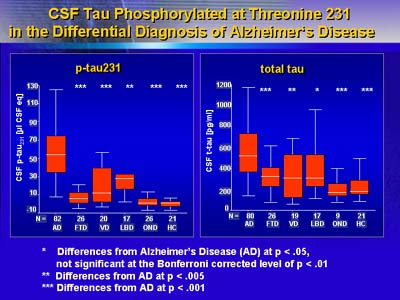Researchers have focused on mild cognitive impairment as a clinical criterion for diagnosis of early Alzheimer's disease. Yet, monitoring of clinical course in early Alzheimer's disease is often difficult when using clinical measures of sometimes subtle cognitive dysfunction. A recently developed SANDWICH enzyme-linked immunosorbent assay method has potential to facilitate disease monitoring by measuring a possible marker of disease severity--spinal fluid concentrations of tau protein phosphorylated at threonine-231 (p-tau231).

Dr. Hampel conducted a longitudinal study of cerebrospinal fluid tau protein concentrations in normal controls, patients with mild cognitive impairment, and patients with Alzheimer's disease. He found a stronger correlation between changes in cognitive impairment and changes in p-tau231 concentrations than between changes in cognitive impairment and changes in total tau protein concentrations.
Dr. Hampel also studied the specificity of p-tau231 for Alzheimer's disease by measuring p-tau231 spinal fluid concentrations in healthy controls and in patients diagnosed with Alzheimer's disease, front-temporal dementia, vascular dementia, Lewy body dementia, and other neurological disorders. Spinal fluid concentrations of p-tau231 were significantly higher in the patient group with Alzheimer's disease than in other patient groups.
Specificity of tau protein for distinguishing Alzheimer's disease from front-temporal dementia (also associated with high tau protein concentrations) was significantly improved by comparing concentrations of p-tau231 and total tau. Mean spinal fluid concentration of p-tau231 in patients with mild cognitive impairment was significantly higher than that of controls and that of patients with other neurological diseases, including front-temporal dementia. Patients with mild cognitive impairment had a lower mean spinal fluid p-tau231 concentration than did patients with a level of cognitive impairment consistent with Alzheimer's disease.
Longitudinal measurement of p-tau231 showed an initial direct relationship with severity of cognitive impairment. After cognitive impairment increased to a level of severity consistent with a diagnosis of Alzheimer's disease, p-tau231 concentrations decreased linearly with progression of disease.
Dr. Hampel believes that a biomarker may prove useful for diagnosis and clinical monitoring of patients with progressive cognitive impairment. Further research will clarify whether spinal fluid concentration of p-tau231 is valid, sensitive, and specific enough to serve as a biomarker for Alzheimer's disease.